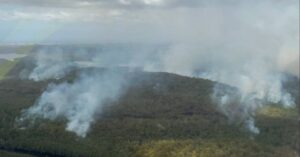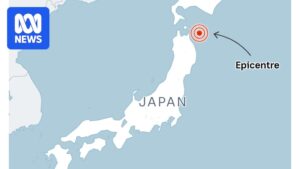
At least two people have died as Super Typhoon Fung-wong approaches the Philippines, unleashing havoc with torrential rains and fierce winds across the central and eastern regions. The typhoon’s imminent landfall in northern Luzon has prompted widespread evacuations, affecting over a million residents.
The Bicol region has been particularly hard-hit, with power outages reported as the storm’s intensity escalates. Authorities have issued urgent evacuation orders, particularly in the Aurora province, where Fung-wong is expected to make landfall as early as Sunday night, local time.
The typhoon is currently lashing Luzon with sustained winds of 185 kilometers per hour and gusts reaching up to 230 kilometers per hour. In response, the government has placed more areas of Luzon under the highest storm warning levels, while Metro Manila and nearby provinces remain at level three.
Impact and Response
The civil aviation regulator has taken precautionary measures by closing several airports, including Bicol International Airport and Sangley in Metro Manila. Meanwhile, the civil defense office has reported fatalities, including a drowning in Catanduanes and a woman found under debris in Catbalogan City.
Fung-wong, locally known as Uwan, is the 21st storm to hit the Philippines this year, a country that typically experiences around 20 storms annually. This latest storm threatens to compound the challenges faced by the nation as it recovers from Typhoon Kalmaegi, which resulted in 224 deaths in the Philippines and five in Vietnam.
Forecast and Future Path
According to the Philippine Atmospheric, Geophysical and Astronomical Services Administration (PAGASA), Fung-wong is expected to move northwest on Monday, then shift north by Tuesday while maintaining its typhoon intensity. By Wednesday, it is projected to head towards the Taiwan Strait, weakening before making landfall in western Taiwan on Thursday. The storm is anticipated to weaken significantly before reaching the Ryukyu Islands.
Authorities Urge Compliance
Defense Secretary Gilberto Teodoro has made a public appeal for residents in the storm’s path to follow evacuation orders. “We ask that people pre-emptively evacuate so that we don’t end up having to conduct rescues at the last minute, which could put the lives of police, soldiers, firefighters, and coast guard personnel at risk,” he emphasized.
In a press conference, civil defense official Raffy Alejandro expressed hope that the proactive measures would minimize casualties. The military has reallocated approximately 2,000 troops from field training to focus on humanitarian assistance and disaster response efforts.
Voices from the Ground
In Isabela, northern Luzon, families have taken refuge in makeshift evacuation centers such as basketball courts. Christopher Sanchez, a 50-year-old evacuee, shared his concerns: “We heard on the news that the typhoon is very strong, so we evacuated early. We left our things on the roofs of our house, since every time there’s a storm, we come here because we live right next to the river.”
“In previous storms, the floodwaters rose above human height. We’re scared. We’re here with our grandchildren and our kids. The whole family is in the evacuation area,” Sanchez added.
Historical Context and Future Implications
The Philippines is no stranger to the wrath of typhoons, with its geographical location making it particularly vulnerable to such natural disasters. The country has been working to improve its disaster preparedness and response strategies, yet the recurrent storms continue to test its resilience.
As Fung-wong advances, the focus remains on safeguarding lives and minimizing damage. The government’s efforts to enforce early evacuations and close strategic locations like airports underscore a commitment to proactive disaster management. However, the long-term challenge lies in rebuilding and strengthening infrastructure to withstand future storms.
As the storm progresses, authorities and residents alike remain on high alert, bracing for the potential impact and preparing for the recovery efforts that will follow.





